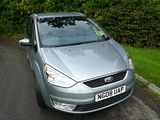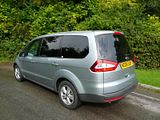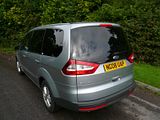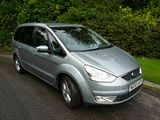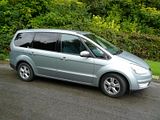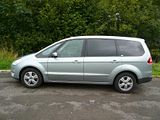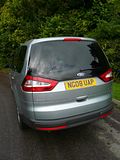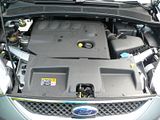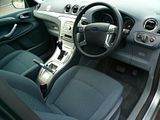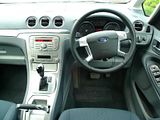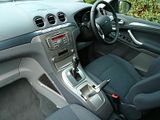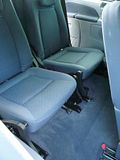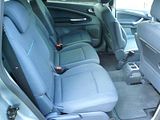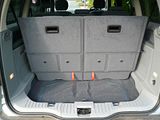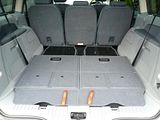Most of my UK car rentals are for one-way journeys either from my Bristol home to London Heathrow, or vice versa. I learned a while ago that one-way car rentals can change the choice of car allocated to you quite significantly, almost regardless of what has been booked, which if the reservation is for work purposes will, thanks to corporate expense policy, be a Group C (Focus or equivalent) car. Heathrow tend to use the opportunity to offload something that they would rather not see again, so in recent times, they have often given me one of the worst cars (in age or condition if not actually in model type) with little chance of persuading them to offer anything else, whereas going the other way, often there are cars that “need” to get back to Heathrow and it is easier to get a customer to take them there than to have to transporter them, so I have often had something quite unlike what I booked. This was one of those occasions. The Hertz Bristol Downtown location is a small facility that is actually nowhere near “Downtown” but which is a few minutes walk from my office. When I turned up on this occasion I was asked if I would mind taking a Ford Galaxy as they had one and needed to get it back to Heathrow. Although it was a 2008-plated car, it had done quite a significant mileage, as many rental cars seem to have done at present, but as I’d not driven one before, I was happy to oblige.
The first Galaxy was in production for 10 years. It was a joint development with VW, who offered their own car, the Sharan, and a Seat badged model, the Alhambra, but when It came to a replacement, Ford decided to go it alone. The second generation Galaxy shares nothing more than a badge with its predecessor, and it is even built in a different country – Genk in Belgium, as opposed to Portugal where the first one was made. We got our first glimpse of what Ford were planning at the Frankfurt Show in September 2005 when a concept was shown, and whilst it was clear that this was close to the upcoming production model, no technical details were included. These came a few months later when the production model made its debut at the 2006 Geneva Show, as a large 7-seater MPV, which was joined by a slightly smaller and sportier stablemate, the S-Max. lt was the S-Max that seem to get most of the attention, and also received universally good reviews, with the car being praised for being spacious and practical as well as good to drive. I sampled one in the summer of 2007 and thought it good, though the 2 litre petrol engine of the that test car was perhaps its weakest feature. That said, most S-Max and Galaxy models will be sold with diesel engines. The more practical and larger Galaxy – it is 52mm wider and 65mm longer than the S-Max, and a true 7-seater as opposed to a 5 +2, got rather less coverage. In the two years since the launch of this second generation Galaxy, it is still not that common a sight on British roads, unless you happen to be in London, where you cannot help noticing that taxi firm Addison Less seem to have bought rather a lot of them. So how good would it turn out to be?
Ford launched this Galaxy using ts own engines as opposed to the VW units of it predecessor. There’s one petrol unit, the 2.0-litre Duratec HE 16v which generates 145PS and peak torque of 190Nm. and which comes with the MTX-75 Durashift five-speed manual transmission. There are two diesels: the Duratorq TDCi 1.8-litre diesel engine offers 125PS and a steady state peak torque of 320Nm (340Nm under transient overboost), and this is also available as a power-reduced 100PS version to suit the cost-of-ownership parameters driven by insurance and tax rates in certain markets, though this does not include the UK and two transmissions are available, the Durashift MTX75 five-speed manual or the Durashift six-speed manual; the other engine is the Duratorq TDCi 2.0-litre diesel engine with 140PS and a peak torque of 236 lb/ft (20Nm or 340Nm under transient overboost). It comes with Ford’s Durashift six-speed manual transmission as standard, though a few months after launch, Ford made the 6 speed Aisin-Warner automatic box available as an option and that is what was fitted to the test car. I would not describe this as a class-leading engine, but it is adequate for the purpose. There is no doubt when you start it up that this is a diesel, with the characteristic noise very evident, but it does become rather more subdued once underway and on the motorway, noise levels are pleasingly low. 140 PS might not sound like a lot for a car of this size and weight, but it is the torque which is rather more significant, and this does mean that in fact when out and about and in traffic and needing bursts of acceleration, the Galaxy is well able to keep up with everyone else. The transmission was generally smooth and found the right gear for the circumstances. The S-Max impressed as it felt surprisingly car-like to drive. The Galaxy is based on the same platform, and uses the same componentry but the car is bigger, heavier and has a higher centre of gravity, so not surprisingly it is not as car-like. It’s still not bad, though, and manages to hide its bulk quite well. The steering is good, as it tends to be in a Ford, with well-judged weighting, and plenty of feel. so you really do know exactly what the steered wheels are doing. The handling is good, too and there is ample grip and with surprisingly little body roll. Tuned for greater comfort than the S-Max, the Galaxy rides well, too, with the softer suspension and long wheelbase absorbing the bumps pretty well. The brakes are powerful. The Galaxy features the same rather odd handbrake as I found in the S-Max. It is awkward to use, and proved especially difficult to release and I could see no real benefit that this strange shaped device conferred compared to a traditional pull-up handbrake. With a generous glass area, including a truly vast windscreen, visibility is good and judging the back of the car, although it does seem to be rather a long way away, is not that hard, so manoeuvering the car in confined spaces is not quite as challenging as you may fear for one so big.
The interior is similar to that of the S-Max, and follows current Ford thinking and detailing. Sadly that means that the materials used are not that impressive, with a lot of shiny silver plastic which will never convince you that it is anything else. That said, the dash is neat and well laid out and easy to use. There is a grouping of instruments under a single binnacle, with larger speedometer and rev counter straddling the smaller fuel level and water temperature gauges. All are clearly marked and easy to read. There are twin column stalks for indicators and wipers. Lights operate from a rotary dial on the dash to the right of the wheel. The centre of the dash contains three high-mounted air vents and beneath this is a full integrated audio unit which will be familiar to those who have driven other modern Fords. The buttons are all large and easy to use. The unit includes AM/FM radio, a CD slot and Bluetooth connectivity. Beneath this unit are a series of buttons for the automated climate control. That’s more or less it, so it is quite an uncluttered look, just ruined by those horrid silver inlays.
Seat upholstery is all cloth, but what you really notice as you get in the Galaxy is a feeling of space. There is a lot of headroom, and the front passenger seat seems to be quite a way away. Seat adjustment is all manual, and there is a telescoping steering wheel, so it was easy to get comfortable. You do feel that you are driving something bigger and taller than a conventional family saloon but the feeling is not intimidating. That impression of space persists as you look at the passenger compartment, All Galaxy models are sold as a 7-seater. There is lots of room for those in the middle row of seats, which comprises three separate seats which abut together, but which can be individually adjusted. They are on sliders. There is particularly generous headroom and more than sufficient leg room even when the front seats are set well back. The central tunnel is very low so there is not much of a problem for the middle seat occupant. There are fold down trays on the back of the front seats which would be useful, for sure. The third row consists of two separate seats. To gain access to the third row, you pull a handle on the second row seat and it slides forwards and tilts up out of the way, so getting in as not as hard as it can be with some 7-seaters, but a degree of athleticism is still called for. Once installed, there is enough space for adults. These are proper seats, mounted high enough that you won’t feel like your knees are in your chin and there is enough legroom and headroom to be surprisingly comfortable – no doubt this is the reason why the car is so popular as a taxi. The tailgate is massive and accordingly, also quite heavy. It lifts to reveal a better-sized boot than you typically get with a 7-seater. In particular it is quite deep with a noticeable well, which is because there is no spare wheel under the floor to claim any space. This meant I had no problems in getting my luggage in without having to lower a seat. The third row seats fold down individually and once both are down, there is a large load bay and this becomes truly massive if you also drop down the middle row of seats, resulting in an almost flat load area extending a full 2.1 metres in length and amounting to 2325 litres in volume. The seats cannot be physically removed but they are easy to fold down using the Fold Flat System (FFS) which means you just pull one strap to raise or lower them. Ford say that there are 32 possible combinations of seat positions and that total luggage space is 30% greater than on the previous Galaxy. There is plenty of provision for odds and ends in the cabin – 30 separate compartments, apparently – with door pockets on all four doors, a decently-sized glovebox, a lidded area in front of the gearlever as well as a open cubby and cup holders in the centre console area.
Ford offer the Galaxy in three trim levels: LX, Zetec and Ghia. My test car was a Zetec. You can choose most of the engine and transmission options with any of the three trims. LX trim covers all the basics, but is not really what you would call luxurious. Standard features include front fog lights, roof rails, Ford’s useful heated front windscreen, steering-wheel mounted audio remote controls and heated electric mirrors but you may not much like the 16″ steel wheels of that the seat adjustment is manual and your passenger may miss the lack of a height adjuster on their seat. Only the front windows are electrically operated. The Zetec is a more popular option and this brings with it 16″ alloy wheels, an alarm, climate control, an electrically adjustable driver’s seat, electric rear windows and rear parking sensors. The Ghia has a different design of larger 17″ alloy wheels, cruise control, some highly questionable wood-effect interior trim. After the test car was built, in March 2008, Ford changed the entry level trim name to Edge, to fit in with the rest of their range and they added a Titanium trim to the top of the range.
I was pleased to be able to test out this Galaxy and on the whole, most of what I found was good. It went quite well, and was decently refined once up to speed. It was nothing like as intimidating to drive as its size might lead you to fear. There’s masses of space in it, which felt almost wasted when I drove it solo with just one medium-sized suitcase and it felt well put together even if the quality of some of the materials was a bit questionable. In summary, there were no significant weaknesses. so for those who are looking for a car of this size which can carry up to 7 adults then the Galaxy would seem to be well worth of consideration. That you don’t see that many of them, apart from those Addison Lee taxis, suggests that in the UK there are not that many people who are looking for such a vehicle.


